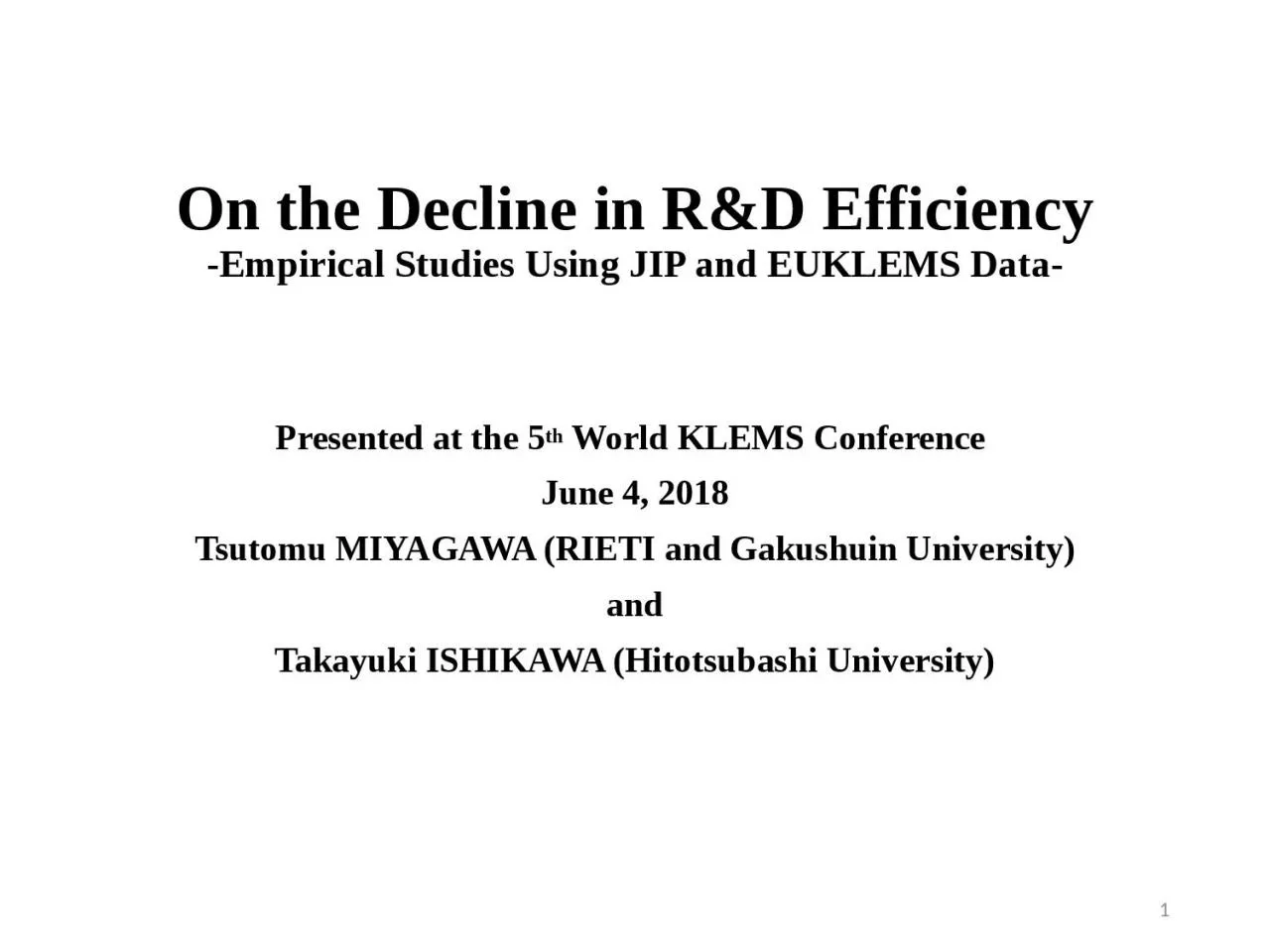

Empirical Studies Using JIP and EUKLEMS Data Presented at the 5 th World KLEMS Conference June 4 2018 Tsutomu MIYAGAWA RIETI and Gakushuin University and Takayuki ISHIKAWA Hitotsubashi ID: 999305
Download Presentation The PPT/PDF document "On the Decline in R&D Efficiency" is the property of its rightful owner. Permission is granted to download and print the materials on this web site for personal, non-commercial use only, and to display it on your personal computer provided you do not modify the materials and that you retain all copyright notices contained in the materials. By downloading content from our website, you accept the terms of this agreement.
1. On the Decline in R&D Efficiency-Empirical Studies Using JIP and EUKLEMS Data-Presented at the 5th World KLEMS Conference June 4, 2018Tsutomu MIYAGAWA (RIETI and Gakushuin University)andTakayuki ISHIKAWA (Hitotsubashi University)1
2. 1. Motivation(1)Discussions on secular stagnation in advanced countriesTwo types of discussions-The discussions from the demand side: Large GDP gap should be filled with the expansion of fiscal policy ←Summers-The discussions from the supply side: The second Solow paradox→mismeasurement in quality in new service generated from technological progress (Brynjolfsson and Aghion vs. Syverson and Byrne, Fernald, and Reinsdorf)2
3. 1. Motivation(2)Another pessimistic view by Gordon (2016): The era of big innovations is over, and the current level of productivity growth is normal.Bloom et al. (2017) : Related issue to the Gordon’s view →The decline in R&D efficiencyThe aim of our study: Based on Bloom et al.’s framework, we investigate the decline in R&D efficiency using JIP database and EUKLEMS database. 3
4. 2. The Concept of Bloom et, al (2017) (1)Bloom et al. (2017) argued that productivity growth (/A) is expressed as follows, productivity growth=R&D efficiency(g) * effective R&D (1)Equation (1) is derived from an ‘idea’ production function and standard Cobb-Douglas production function. : R&D expenditure.: R&D productivity. 4
5. 2. The Concept of Bloom et, al (2017) (2)From (2) and (3), and using we obtain (4)From F.O.C. and the definition of R&D intensity, then, we obtain (5) 5EffectiveR&D Expenditure
6. 2. The Concept of Bloom et, al (2017) (3)From (4) and (5), we obtain・In Equation (6), capital/output is constant along a balanced growth path. Then, we obtain = (=) 6
7. U.S. TFP and R&D Data7From Bloom et.al (2017).
8. JPN TFP, LP (Manufacturing), and R&D data8
9. 3. Our strategies on the measurement of gTwo ways to measure gThe direct measurement using KLEMS DatabasesEstimation of g9
10. 4. The Direct Measurement of g (1)Based on Equation (1), we measure g directly using the JIP and EUKLEMS databasesInternational comparison: We focus on the recent two decades (1995-2015). We normalize the R&D efficiency in the first decade as 1 and express the R&D efficiency in the second decade as the ratio to that in the first decade.R&D efficiency declined in the second decade in all advanced countries.In the information service, Japan shows the largest decline among advanced countries.10
11. 11
12. 4. The Direct Measurement of g (2)Using the JIP database, we measure g in the longer period.We take the data on productivity and R&D of the recent 30 years and divide into two periods (1980-95 and 1996-2012).We find that R&D efficiency has declined in the recent 15 years in the whole manufacturing sector.However, in some sophisticated industries such as textile, paper, and ceramics, we find that R&D efficiency has increased due to the drastic decline in capital assets.12
13. -Ratio by industry in Japan 13
14. 5. Estimation of g (1)We estimate the R&D efficiency based on the following equation. is the productivity. is the TFP growth rate or LP growth rate.We use 5-year moving average (1980-2012).Non constant Pooled OLS.All data are obtained from the JIP database. 14
15. 5. Estimation of g (2)R&D efficiency in the 1980s is negative, because many Japanese firms conducted not only applied research but also basic research that did not lead to the short-term productivity growth.It rose in the 2000s. Fukao et al. (2013) argued that effective R&D facilities remain in Japan after many Japanese firms moved some of their inefficient R&D facilities abroad.However, when we look at the estimation results using labor productivity, we find that R&D efficiency has slowly declined.15
16. Estimation Results (1)16
17. 5. Estimation of g (3)We examine the complementary effects of intangible assets on R&D efficiency.Then, we estimate the following equation including the “Intangible-Invest effect”. 17
18. 5. Estimation of g (4)There are two types of intangibles: one is intangibles excluding R&D and the other is intangibles excluding R&D and software. We take three year lags for intangible investment data.Estimation results show that intangible investment contributes to the increase in R&D efficiency significantly in the case of intangibles excluding R&D.When we examine the sum of first two coefficients, that in the first 15 years is larger than that in the second 15 years. It implies the decline in R&D efficiency, when we consider complementary effects of intangibles.18
19. Estimation Results (2)19
20. Estimation Results (3)20
21. 6. Concluding remarksUsing the JIP and EUKLEMS databases, we examine the plausibility of the decline in R&D efficiency as Bloom et al. (2017) suggested.The direct measure of R&D efficiency using KLEMS databases show that the R&D efficiency has declined in advanced countries. In some Japanese industries such as textile, paper, and ceramics, R&D efficiency has increased in the recent 15 years due to the restructuring in those industries.Estimation of R&D efficiency shows that it declined drastically in the1990s in Japan. We also find that intangible investment contributes to the increase in R&D efficiency.21
22. 7. Future research agendaEstimating g, when we consider capital/output ratio is not constant.Examining the decline in R&D efficiency using firm-level data.22
23. Thank you for your attention!23